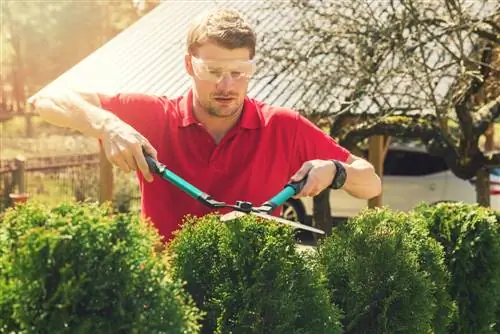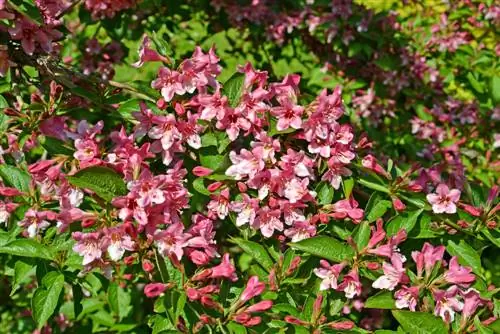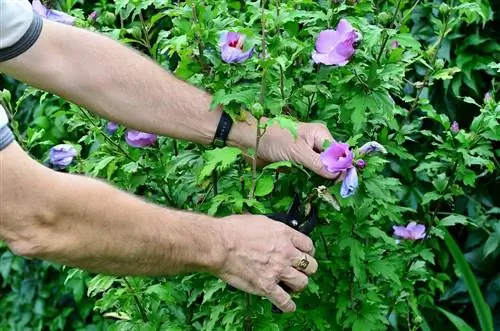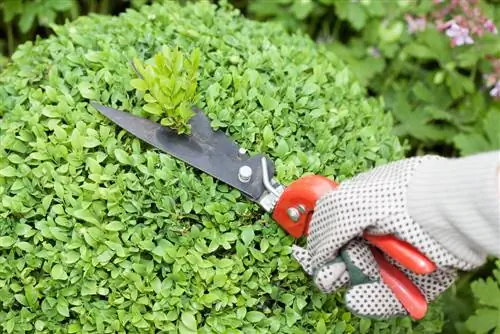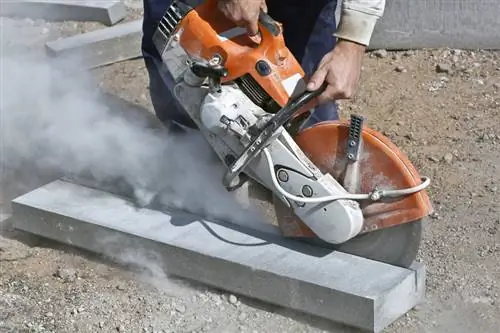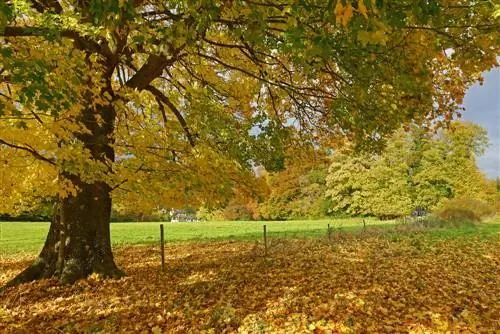- Author admin [email protected].
- Public 2023-12-16 16:46.
- Last modified 2025-06-01 06:02.
Conifers are the evergreen constant in the floral interplay of the garden. Fir, pine, cypress, spruce and yew hardly change their shape over the years because they grow slowly and wear their needles all year round. In contrast to deciduous trees, care must be taken when caring for prunes. A regulating cut is still advantageous as long as important premises are taken into account. In this tutorial you will learn everything you need to know about expertly pruning conifers.
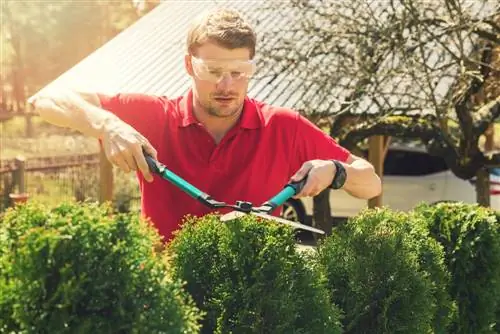
Why should conifers be pruned every now and then? - Types of cuts and dates
Conifers grow extremely slowly - but they grow. In contrast to deciduous trees, conifers only growgrowthat theshoot tips. Below their needles, the trees and shrubs have stopped growing forever. In open coniferous and mixed forests, the process takes place in a regulated manner, without pruning taking place or being necessary. Limited garden areas, cultivation as a hedge or topiary make horticultural intervention necessary to regulate growth from time to time. The following table summarizes all options for pruning conifers:
| Cut style | Goal/Occasion | best date | optional, second appointment | optional third appointment |
|---|---|---|---|---|
| Solitaire construction cut | shapely habitus, reliable stability | February to early March | End of June to mid-July | none |
| Preservation cut solitaire | Growth regulation | if necessary in late winter (February to early March) | possibly end of June to mid-July | none |
| Topiary solitaire | Design of geometric or artistic shapes | End of February/beginning of March | End of June to mid-July | Early to mid-August |
| Plant cutting hedge | strong branching at the base | after planting | February of the following year | none |
| Build-up cut hedge | opaque, light-flooded growth | February to early March (main date) | End of June to mid-July (strong-growing varieties) | Mid to late August (vigorous varieties) |
| Topiary hedge | Preservation of shape, height and width | End of June to mid-July (main date) | Mid to late August (optional) | none |
Conifers cannot survive a rejuvenation cut. The trees do not produce dormant buds that sprout as an “iron reserve” if twigs, branches or trunks are lost. The only exception is the yew, for which a separate tutorial is dedicated to pruning care, including instructions for rejuvenating pruning.
Remember when pruning conifers - rule of thumb prevents cutting errors
For those new to gardening and experienced home gardeners who are cutting a conifer for the first time, a simple rule of thumb provides security when making cuts:
Cut little on conifers and only in the needled, green area
As long as you practice pruning in a “green coat”, you can’t go wrong with coniferous trees and coniferous shrubs. An exception applies to completely dead branches that you saw off at the base or on the astring. From this perspective, pruning on conifers is less complicated than on deciduous and flowering trees. When pruning shrubs and trees, you need to familiarize yourself with numerous factors, such as flowering time, bud formation and pruning tolerance. When pruning conifers, you only need to keep an eye on the green (sometimes blue or golden yellow) needles, in which area pruning is possible.
Build-up cut on the solitaire optimizes shape and stability - cutting instructions
If you cultivate a fir, spruce, pine or other tree-like conifer in your garden, you can safely skip this section of the tutorial. These conifer species naturally develop a stable, vitally branched framework and do not become bare even after many years. Shrub-like coniferous trees, such as arborvitae (Thuja), Leyland cypress (Cupressocyparis leylandii), yew (Taxus) or false cypress (Chamaecyparis lawsoniana)benefit from a targeted build-up cut.
Upright-growing, bushy conifer species form several scaffolding shoots that compete with each other. With all its might, each individual shoot strives towards the exposed outside and from there towards the sky. This results in a one-sided weight shift in the first few years, which is fatal to the plants in the event of snow pressure and storms. Patient and expert pruning aims to create a stable structure that will give your conifer a lifelong stability. How to do it right:
- Frequency of pruning depends on species-specific vigor
- The best time is in late winter, before budding begins
- Prune fast-growing conifers again at the end of June and mid-August
- 3 select dominant ground shoots and let them grow uncut
- Subordinate additional ground shoots to the scaffold shoots and divert them to deeper, short side shoots every few years
A step-like structure of ground shoots and side shoots that gather around the 3-frame structure optimizes stability and protects your conifer from wind and snow breakage. Please note that slow-growing conifersdo not need to be cut every year. If the annual growth is limited to 2 to 5 centimeters, as with some pine or juniper species, the scissors are used every 2 to 3 years or less frequently.
Background
Derivation cut with key function in conifer cutting
If conifer gardeners are familiar with derivation pruning, pruning can be carried out masterfully. The pruning technique comes from the sophisticated pruning of fruit trees and has proven to be beneficial for all deciduous and coniferous trees. If you simply cut off branches on conifers that are too long or poorly positioned, you will leave a gap even if you move within the green needle area. A lead cut prevents this shortcoming. Examine the shoot in question for a green, short side shoot further down. Cut off the old shoot where the young shoot branches off. Place the scissors just behind thefork to avoid damaging the young wood.
Pruning keeps conifers in perfect shape - cutting instructions
Solitary conifers or shrubs thrive for many years without the need for pruning. As they get older, the shape of pine, juniper, fir and other conifers sometimes leaves something to be desired. If bare branches that are too long or dying are affecting the appearance, intervene promptly as long as you can cut in the needled area. The best time is in late winter, before new growth begins. Alternatively, another time window is open from the end of June to mid-July.
Direct branches that are growing unfavorably in the needled area onto a more favorable, short side branch. The figure below shows the correct procedure. Bend the branch in question to the side in advance to identify any possible gaps. If necessary, move the interface slightly outwards until any bare spots are covered by needle-covered side shoots.

If a conifer shoot becomes too long, a derivation cut solves the problem. Cut the shoot back to a young, green side branch, which continues to grow as a new tip at this point.
Tip
Young fir trees sometimes have two or three vertical central shoots, all of which would like to take the top position. If a double or triple top is not in your interest, thin out the weakest shoots in summer while they are still green.
Topiary cutting for a green work of art - this is how a conifer sculpture works
Conifers are very popular for designing them as balls, cones, pyramids and artistic figures. Basically, the special variant of training follows the pruning rules for the conifer hedge. Depending on the type of tree chosen, pruning is carried out more frequently to regulate growth and shape. Use slender conifers to create pyramids or spirals, such as Thuja 'Smaragd'. Ball arborvitae varieties such as 'Danica' or 'Tiny Tim' naturally have a spherical habit. Stencils made of wood or wire provide valuable help in achieving a flawless result. The following overview summarizes the central framework conditions for topiary cutting on conifer sculptures:
- Time window for topiary: beginning of March to the end of August
- Build up the conifer gradually in stages of a maximum of 5 centimeters growth
- Design the shape from the start using a template
- It's better to cut often and little, instead of rarely and a lot
- Concentrate cutting circumference on the needle area
Premium conifer for topiary as a green work of art is the yew. Taxus is the only coniferous tree that tolerates cutting into unneeded wood. This means that small cutting errors in the heat of the moment are not immediately punished with brown spots and gaps. However, the yew is very poisonous and not suitable for the family garden.
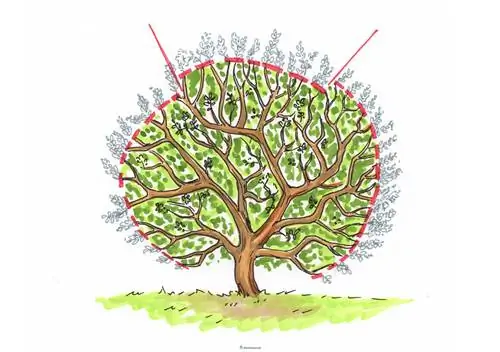
Build a conifer in stages for artistic topiary. Stencils provide valuable guidance for the perfect cut when creating and maintaining cones, pyramids and fantasy figures.
Shaping conifers for garden bonsai - tips for pruning training
Conifers shaped into bonsai catch envious glances over the garden fence. The masterpiece is achieved by making an annual cut along theshoot tipsYou give the trees the artistic shape usingwires, as is common in small format indoor bonsai is there. If you start training your garden bonsai as early as possible, the conifer will thrive with short, dense shoots. In this way, even beginners can achieve the trendy tiered growth that is particularly popular with pine trees.
Cutting the conifer hedge on the day of planting - this is how you do it right
When purchasing conifers for hedge planting, please pay attention to more than just the height of the dominant central shoot. Your conifer hedge will bring you a lot of joy if it starts with a total ofdensely branched young trees. Don't rely on your sense of proportion when planting. To ensure that the row of bushes is arranged straight, please stretch strings as a guide. Before you water the new hedge with fresh water, dedicate yourself to the following plant pruning:
- Rule of thumb: the younger the hedge conifer, the stronger the cut on the day of planting
- Short plants up to 30 cm tall by at least a third
- Plants over 30 cm tall should be trimmed by 5 to 10 cm in height and by a third on the sides and flanks
Please clear away the clippings before treating your new hedge with starter fertilization. Sprinkle 100 to 150 grams of horn shavings onto the planting strip for each meter of hedge and water. Finally, spread a thin layer of compost or bark mulch to prevent the soil from drying out.
Background
Pruning acts as an effective diversion of reserve substances
What the deflected shot is supposed to achieve in football is done by the plant cutting in conifers. If the ball does not fly in the desired direction, the player redirects the trajectory towards the goal. In woody plants, the growth juices push towards the top buds, where a correspondingly strong shoot takes place. Deeper buds are not or minimally involved in distribution. In this regard, the goals of the conifer and the gardener do not coincide. In order for hedge bushes to branch vigorously at the base, the plant sap must be redirected. This can be achieved by removing the top buds with a bold plant cut. From now on, buds planted deep down benefit from the newly distributed sap pressure and sprout diligently.
Pruning on conifer hedges pays off
Conifers grow on average 10 to 20 centimeters per year. Thuja Smaragd or Taxus baccata, with annual growth of 30 centimeters, are already considered growth rockets in the conifer kingdom. It takes many years of patience until a hedge with a privacy function is formed. Even a knee-high bed or grave border takes several years to reach the desired shape and height.
Many home gardeners make the understandable mistake of letting a conifer hedge grow uncut in the first few years. Without pruning, the coniferous trees lose their stability and beauty. If you subject your new conifer hedge tosuccessive pruning, it will grow densely bushy and stable. How to do it correctly:
- Cut the conifer hedge at least twice a year during the establishment years
- With each cut, leave 5 cm from the previous growth
- Best dates are February and the end of June (optionally a third time in mid/end of August)
- Stretch up cords as a marking aid for aconical hedge profile
- Make the hedge base a third wider than the hedge crown
- Remove all inward-facing and noticeably weak shoots
The image below demonstrates the perfect hedge shape asTrapezoidWhen conifer hedges taper towards the crown, the individual coniferous bushes thriveflooded with light This has the advantage that the green needle coat extends deep into the interior of the hedge and offers a reliable privacy factor. In addition, less snow remains on a narrow hedge surface, which reduces the risk of snow breakage. Last but not least, hedge scaffold shoots do not fall apart, as is the case with uncut conifer hedges.
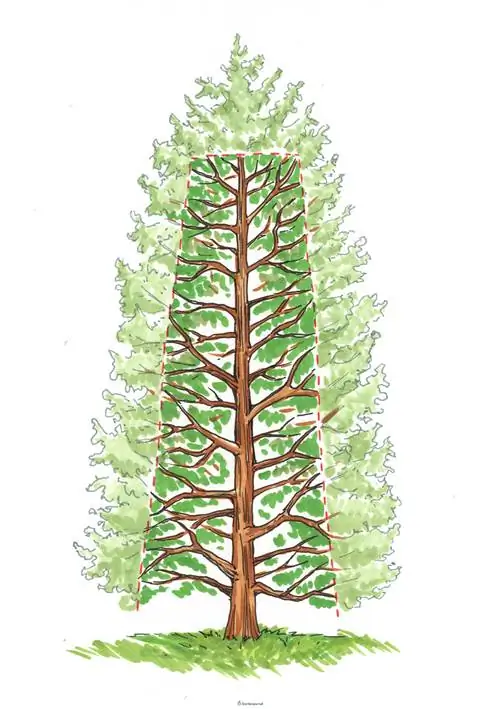
Conifer hedges in a trapezoid shape are denser, bushier, more stable, have a harmonious shape and do not fall apart. For this purpose, the build-up pruning is dedicated to gradual height growth of a maximum of 10 centimeters per year.
Conifer hedge in top form - instructions for topiary
Once your conifer hedge has reached the desired height and shines with its rich needlework, it is up to the topiary to maintain its splendor. The cutting measure focuses on this year's growth, so that you do not come into conflict with the Federal Nature Conservation Act with the ideal date at the end of June and optionally in mid-August. Hedge trimming is permitted during the grace period from March 1st to September 30th, provided the scope is limited to this year's growth. How to cut correctly:
- Check the hedge in advance fornesting birds and reschedule the appointment if necessary
- Cut dead shoots and those growing inside the hedge with one-handed scissors
- As a guide for aconical cutting profileStretch cords along the hedges
- Swing the hedge trimmer up and down with stretched arms parallel to the cutting surface
- Cut the top of the knife bar from the back in a horizontal position
Cut toshortly close to the last interfacesand stay in thegreen area Further growth is no longer possible in this phase Advantage, but over the years it creates space problems. Just 1 centimeter of growth per side per year will increase the size of the hedge by a whopping 20 centimeters after 10 years.
Cut strong conifer hedges in February
For the pruning of vigorous arborvitae or false cypresses, gardening practice has proven that an initial topiary in February sends the hedges into spring with a well-groomed appearance. If you are dissatisfied with your conifer hedge at the end of winter, don't hesitate to reach for the hedge trimmer. Cut the green beauty on an overcast, frost-free day. Just in time for the first holidays of the year, such as Easter or children's communion, you can look forward to a representative appearance.
Excursus
Electrically cut large conifer hedges into shape
For cutting a majestic conifer hedge more than 10 meters long, we recommend an electrically operated hedge trimmer. Please remember that you are cutting in the middle of the breeding season and the noise of petrol engines will scare away the birds in your garden. So that a long power cable doesn't get in your way, simply place it over your shoulder. If your condition allows it, trim smaller hedges manually with a two-handed hedge trimmer. Modern shrub shears with battery operation are powerful and can also handle larger hedge areas. If necessary, a spare battery should be charged and ready to hand so that you can complete the topiary without annoying interruptions.
Frequently asked questions
My 8 year old sugarloaf spruce (Picea glauca 'Conica') is starting to get a little too big for me. Can I cut back the conifer for the first time in March?
Light pruning is possible at the end of the winter dormancy. It is important to note that you only cut a little and do not pierce the “green coat”. Inside the tree, the needles are brown and dead due to the lack of light. If you cut the sugarloaf spruce too deeply, holes will appear that will be visible for many years. The conifer is not able to close the gaps from the inside with green needles.
Our Nordmann fir tree has brown shoot tips after a hard winter with temperatures below -20 degrees Celsius. The fir tree is still beautifully green inside. Can I cut off the brown tips?
The Nordmann fir is naturally very frost hardy. If the conifer is too dry, severe frosts can damage the young needles at the tips. We recommend not cutting at first, but rather improving the local conditions. Provide the fir tree with sufficient water and fertilizer. With a little luck, the brown branch tips will regenerate on their own and you can save yourself the risk of a cut.
With our new house we bought an old arborvitae hedge that obviously hadn't been pruned for several years. With a width of 2.50 meters and a height of 3.50 meters, the hedge is far too big for us. Can we cut back the trees of life? If yes, when and how does it work?
If you want to make sure that the arborvitae hedge considers pruning, you may only cut in the green shoot area. If you continue cutting into the old, brown wood, a well-established thuja hedge can, with a bit of luck, still cope and sprout again. If the general conditions are not so favorable, there is a risk of a total failure. It is up to you to decide which result is more important to you. The safe survival of the arborvitae hedge or the desired height and width with the risk of having to replant the entire hedge. The best time to prune is in February on a frost-free day.
We planted our atlas cedar (Cedrus atlantica) two years ago. We underestimated the growth power of the conifer because it is already 1.50 meters high and far too big for the current location. We would like to transplant the cedar. When is the best time? Does the cedar need to be cut?
After two years of standing, you are in the appropriate time frame to transplant a conifer. The best time is in late winter or early spring, when there is no longer any risk of severe frosts and the cedar has not yet begun to sprout. For a successful process, it is important that you implement the largest possible root ball. As a conifer, an Atlas cedar should not be cut when changing location. Adequate water and nutrient supply helps the transplanted tree to compensate for the lost root volume.
I intend to keep an eagle's wing yew tree in a pot on the terrace. Can I influence the growth in width in the future by cutting or will the conifer resent me?
Like all yews, the eagle's wing yew tolerates pruning without any problems. However, the bizarre growth habit could be affected by a topiary. We therefore recommend regular and skillful thinning cuts instead of simply shortening branches that are too long.
The 3 most common cutting mistakes
Conifers that are deformed or have brown spots are the victims of pruning errors. It doesn't have to come to this if the gardener is aware of widespread mistakes in conifer pruning. The following table lists the three most common cutting errors with damage patterns and tips for prevention:
| Cutting errors | malicious image | Prevention |
|---|---|---|
| cut too low | brown spots, large gaps | always cut in the needled area |
| no education and development cut | uneven growth, frequent wind and snow breakage, bare hedge base | Build up gradually with 5 centimeters per year |
| put on the stick | Total failure | Never rejuvenate conifers (except yew) |

Tip
Prunings from conifers are generally poisonous to humans and animals. Please do not dispose of cut shoots in the compost or on meadows. Thuja, yew and other conifer species pose a deadly danger to grazing livestock and horses. Place the clippings in the trash can. Composting facilities and landfills accept larger quantities free of charge.

